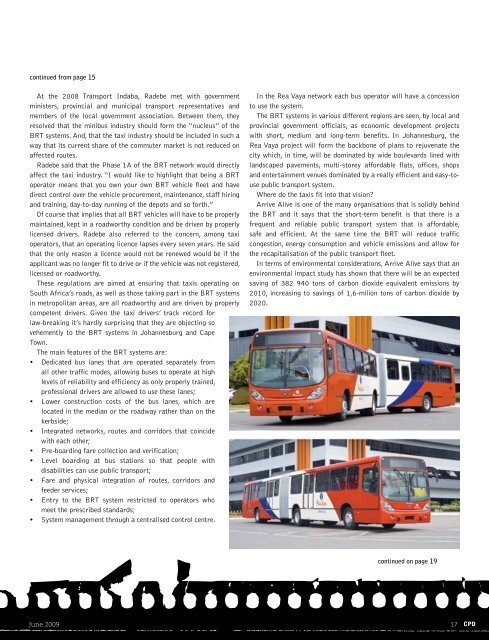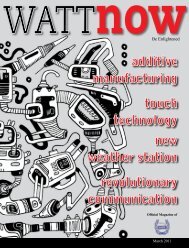download a PDF of the full June 2009 issue - Watt Now Magazine
download a PDF of the full June 2009 issue - Watt Now Magazine
download a PDF of the full June 2009 issue - Watt Now Magazine
- No tags were found...
You also want an ePaper? Increase the reach of your titles
YUMPU automatically turns print PDFs into web optimized ePapers that Google loves.
continued from page 15At <strong>the</strong> 2008 Transport Indaba, Radebe met with governmentministers, provincial and municipal transport representatives andmembers <strong>of</strong> <strong>the</strong> local government association. Between <strong>the</strong>m, <strong>the</strong>yresolved that <strong>the</strong> minibus industry should form <strong>the</strong> “nucleus” <strong>of</strong> <strong>the</strong>BRT systems. And, that <strong>the</strong> taxi industry should be included in such away that its current share <strong>of</strong> <strong>the</strong> commuter market is not reduced onaffected routes.Radebe said that <strong>the</strong> Phase 1A <strong>of</strong> <strong>the</strong> BRT network would directlyaffect <strong>the</strong> taxi industry. “I would like to highlight that being a BRToperator means that you own your own BRT vehicle fleet and havedirect control over <strong>the</strong> vehicle procurement, maintenance, staff hiringand training, day-to-day running <strong>of</strong> <strong>the</strong> depots and so forth.”Of course that implies that all BRT vehicles will have to be properlymaintained, kept in a roadworthy condition and be driven by properlylicensed drivers. Radebe also referred to <strong>the</strong> concern, among taxioperators, that an operating licence lapses every seven years. He saidthat <strong>the</strong> only reason a licence would not be renewed would be if <strong>the</strong>applicant was no longer fit to drive or if <strong>the</strong> vehicle was not registered,licensed or roadworthy.These regulations are aimed at ensuring that taxis operating onSouth Africa’s roads, as well as those taking part in <strong>the</strong> BRT systemsin metropolitan areas, are all roadworthy and are driven by properlycompetent drivers. Given <strong>the</strong> taxi drivers’ track record forlaw-breaking it’s hardly surprising that <strong>the</strong>y are objecting sovehemently to <strong>the</strong> BRT systems in Johannesburg and CapeTown.The main features <strong>of</strong> <strong>the</strong> BRT systems are:• Dedicated bus lanes that are operated separately fromall o<strong>the</strong>r traffic modes, allowing buses to operate at highlevels <strong>of</strong> reliability and efficiency as only properly trained,pr<strong>of</strong>essional drivers are allowed to use <strong>the</strong>se lanes;• Lower construction costs <strong>of</strong> <strong>the</strong> bus lanes, which arelocated in <strong>the</strong> median or <strong>the</strong> roadway ra<strong>the</strong>r than on <strong>the</strong>kerbside;• Integrated networks, routes and corridors that coincidewith each o<strong>the</strong>r;• Pre-boarding fare collection and verification;• Level boarding at bus stations so that people withdisabilities can use public transport;• Fare and physical integration <strong>of</strong> routes, corridors andfeeder services;• Entry to <strong>the</strong> BRT system restricted to operators whomeet <strong>the</strong> prescribed standards;• System management through a centralised control centre.In <strong>the</strong> Rea Vaya network each bus operator will have a concessionto use <strong>the</strong> system.The BRT systems in various different regions are seen, by local andprovincial government <strong>of</strong>ficials, as economic development projectswith short, medium and long-term benefits. In Johannesburg, <strong>the</strong>Rea Vaya project will form <strong>the</strong> backbone <strong>of</strong> plans to rejuvenate <strong>the</strong>city which, in time, will be dominated by wide boulevards lined withlandscaped pavements, multi-storey affordable flats, <strong>of</strong>fices, shopsand entertainment venues dominated by a really efficient and easy-tousepublic transport system.Where do <strong>the</strong> taxis fit into that vision?Arrive Alive is one <strong>of</strong> <strong>the</strong> many organisations that is solidly behind<strong>the</strong> BRT and it says that <strong>the</strong> short-term benefit is that <strong>the</strong>re is afrequent and reliable public transport system that is affordable,safe and efficient. At <strong>the</strong> same time <strong>the</strong> BRT will reduce trafficcongestion, energy consumption and vehicle emissions and allow for<strong>the</strong> recapitalisation <strong>of</strong> <strong>the</strong> public transport fleet.In terms <strong>of</strong> environmental considerations, Arrive Alive says that anenvironmental impact study has shown that <strong>the</strong>re will be an expectedsaving <strong>of</strong> 382 940 tons <strong>of</strong> carbon dioxide equivalent emissions by2010, increasing to savings <strong>of</strong> 1,6-milion tons <strong>of</strong> carbon dioxide by2020.continued on page 19<strong>June</strong> <strong>2009</strong> 17
















